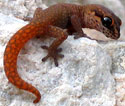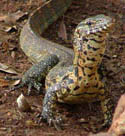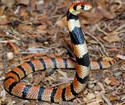|
Squamata (Lizards and snakes)
Life >
Eukaryotes
>
Opisthokonta >
Metazoa
(animals) > Bilateria > Deuterostomia >
Chordata >
Craniata > Vertebrata (vertebrates) > Gnathostomata (jawed vertebrates) >
Teleostomi (teleost fish) > Osteichthyes (bony fish) > Class:
Sarcopterygii (lobe-finned fish) > Stegocephalia (terrestrial vertebrates) >
Tetrapoda
(four-legged vertebrates) > Reptiliomorpha > Amniota >
Reptilia (reptiles) >
Romeriida > Diapsida > Lepidosauromorpha > Lepidosauria
The Squamata have traditionally been split into three major
taxa: the Amphisbaenia (worm lizards), Lacertilia (lizards) and Serpentes
(snakes). However, recent molecular research shows that snakes and worm lizards
evolved from lizards so to pull them out as separate taxa from lizards make the
lizards a paraphyletic group. The name Squamata is derived from the Latin word
squama meaning scale, and members of the Squamata are easiest identified
by their scaly skin, which is shed periodically. A total of about 489 species of
Squamata have been recorded from southern Africa.
Taxa native to southern Africa
|
Gekkonidae (geckos) |
 |
|
Scincidae (skinks) |
 |
|
Gerrhosauridae (plated lizards,
snake-lizards and seps) |
 |
|
Cordylidae (girdled lizards and relatives) |
 |
|
Amphisbaenidae (amphisbaenians
or worm lizards)
These worm-like lizards are adapted for living
underground: they do not have legs, except for 3 species that have still
retained rudimentary forelimbs, they have small, rudimentary eyes, and they
have thick, heavy skulls that are flattened on top to enable pushing away of
soil. They tend to lack pigmentation and are usually pinkish brown. |
 |
|
Lacertidae (lacertids, wall lizards) |
 |
|
Chamaeleonidae (chameleons) |
 |
|
Agamidae (agamas) |
 |
|
Varanidae (monitors)
One genus in southern Africa -
Varanus. |
 |
|
Serpentes (snakes)
Snakes are legless carnivorous reptiles which lack eye
lids and external ears. They have loosely attached jaws which enable them to
swallow prey larger than the size of their heads. Very often they only have
one lung and all other organs lie one behind the other. A large portion of
snakes are non venomous, however there are several whose venom is lethal to
humans. |
 |
|
